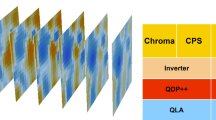Abstract
Signatures of quark-hadron phase transition are probed by the investigation of event-by-event fluctuations of hadronic patterns in heavy-ion collisions. This study intend to measure the event-to-event fluctuation of voids (non-hadronic regions) for the experimental data sets of compound hadrons of 32S-AgBr interactions at 200 AGeV. The bin size dependence of voids is numerically evaluated with two different moments 〈G q 〉 and S q defined by R.C. Hwa and Q.H. Zhang. The scaling behaviour of the voids provides an efficient way to use the scaling exponents γ q and σ q to characterize the various interesting properties of the hadronic phase transition.
Similar content being viewed by others
References
T. H. Brunet, S. Dake, M. Fukl, et al., “Extremely high multiplicities in high energy nucleus-nucleus collisions,” Phys. Rev. Lett. 50, 2062 (1983); Sh. Ahmad, A. R. Khan, A. Kamal, et al., “Signature of void probability scaling in 28Si-nucleus collisions,” Fizika, Ser. B (Zagreb) 16 (3), 159 (2007).
E. A. De Wolf, I. M. Dremin, and W. Kittel, “Scaling laws for density correlations and fluctuations in multi-particle dynamics,” Phys. Rep. 270, 1 (1996).
B. Buschbeck, R. Lipa, and R. Peschanski, “Signal for intermittency in e +-e − reactions obtained from negative binomial fits,” Phys. Lett., Ser. B 215, 788 (1988), W. Brauscheweig, R. Gerhards, F. J. Kirschfink, et al., “Study of intermittency in electron-positron annihilation into hadrons,” Phys. Lett., Ser. B 231, 548 (1988); I. V. Ajinenko, Yu. A. Belokopytov, H. Bottcher, et al. (NA22 Collab.), “Intermittency patterns in π + p and k + p collisions at 250 Gev/c,” Phys. Lett., Ser. B 222, 306 (1989).
M. Dooring and V. Koch, “Event-by-event fluctuations in heavy ion collisions,” nucl-th/0204009.
R. Halynski, A. Jurak, A. Olszewski, et al. (KLM Collab.), “Evidence for intermittent patterns of fluctuations in particle production in high energy interactions in nuclear emulsion,” Phys. Rev. Lett. 62, 733 (1989).
A. Bialas and R. Peschanski, “Moments of rapidity distributions as a measure of short-range fluctuations in high-energy collisions,” Nucl. Phys., Ser. B 273, 703 (1986).
E. A. De Wolf, I. M. Dremin, and W. Kittel, “Scaling laws for density correlations and fluctuations in multi-particle dynamics,” Phys. Rep. 27, 236 (1996).
W. Bari, N. Ahmad, M. M. Khan, et al., “Intermittency in 4.5 A and 14.5 AGeV/c 28Si-nucleus interactions,” Int. J. Mod. Phys., Ser. E 11, 131 (2002).
R. Hasan, S. Islam, and M. M. Haq, “Levy state law of intermittency and multifractal spectrum in 28Si-AgBr collisions at 14.6 AGeV,” Chaos, Sol. Fract. 25, 1029 (2005).
Sh. Ahmad, M. M. Khan, N. Ahmad, and A. Ahmad, “Erraticity behaviour relativistic nucleus-nucleus collisions,” J. Phys., Ser. G 30, 1145 (2004).
R. C. Hwa, “Beyond intermittency: erraticity,” Acta Phys. Pol., Ser. B 27, 1789 (1996).
M. L. Cherry, A. Dabrowska, P. Deines-Jones, et al., “Event-by-event analysis of high multiplicity Pb (158 GeV/nucleon)-AgBr collisions,” Acta Phys. Pol., Ser. B 29, 2129 (1998).
J. G. Reid (STAR Collab.), “STAR event-by-event fluctuation,” Nucl. Phys., Ser. A 698, 611 (2002).
R. C. Hwa and Q. Zhang, “Earraticity of rapidity gap,” Phys. Rev., Ser. D 62, 014003 (2000).
S. Hegyi, Phys. Lett., “Analysis of the rapidity gap probability at CERN collider energies,” Ser. B 274, 214 (1992).
D. Ghosh, A. Deb, S. Bhattacharyya, and G. Ghosh, “Signature of void probability scaling in multipion production at a few GeV/nucleon,” Phys. Rev., Ser. C 69, 027901 (2004); “Void probability scaling in target fragmentation of high energy nucleus-nucleus collisions,” J. Phys., Ser. G 30, 499 (2004).
D. Ghosh, A. Deb, P. Mandal, et al., “Non-statistical fluctuation of compound multiplicity in nucleusnucleus interactions,” Chin. Phys. Lett. 10, 1436 (2002).
D. Ghosh, A. Deb, S. Biswas, et al., “Evidence of multifractal structure of compound multiplicity distribution in 24Mg-AgBr interactions at 4.5 AGeV,” Czech. J. Phys. 53, 1173 (2003).
D. Ghosh, A. Deb, P. Mandal, et al., “Evidence of selfaffine fluctuations of compound multiplicity distributions in nucleus-nucleus interactions at 4.5 AGeV,” Phys. Rev., Ser. C 69, 017901 (2004).
D. Ghosh, A. Deb, S. Biswas, et al., “Compound multiplicity distribution in nucleus-nucleus interactions-phase transition study,” Fizika, Ser. B 14, 317 (2005).
D. Ghosh, A. Deb, S. Biswas, et al., “Evidence of strong two-particle and three particle dynamical correlation in compound multiplicity distribution in nucleus-nucleus interactions at 4.5 AGeV,” Can. J. Phys. 84, 1007 (2006).
R. C. Hwa and Q. Zhang, “Fluctuation of voids in hadronization at phase transition,” Phys. Rev., Ser. C 62, 054902 (2000).
R. C. Hwa and Q. Zhang, Phys. Rev., “Void analysis of hadronic density fluctuations at the quark-hadron phase transition,” Ser. C 64, 054904 (2001).
D. Ghosh, M. Lahiri, A. Deb, et al., “Factorial correlator study in 32S-AgBr interaction at 200 AGeV,” Phys. Rev., Ser. C 52, 2092 (1995).
L. V. Hove, “Final state classification and new phase space plot for many-body hadron collisions,” Phys. Lett., Ser. B 28, 429 (1969).
L. V. Hove, “Longitudinal phase-space plots in multi-particle hadron collisions at high energy,” Nucl. Phys., Ser. B 9, 331 (1969).
L. Liu, Y. Zhang, and Y. Wu, “On the random cascading model study of anomalous scaling in multiparticle production with continuously diminishing scale,” Zeitschrift f. Physik, Ser. C 69, 323 (1995/1996).
D. Ghosh, A. Deb, J. Ghosh, et al., “Evidence of self-affine pion multiplicity fluctuation in relativistic and ultra-relativistic nuclear collisions,” Int. J. Mod. Phys., Ser. A 21, 1053 (2006).
Author information
Authors and Affiliations
Corresponding author
Additional information
The article is published in the original.
Rights and permissions
About this article
Cite this article
Ghosh, D., Deb, A., Mondal, M. et al. Void fluctuation study of compound hadrons: Signatures of quark-hadron phase transition. Phys. Part. Nuclei Lett. 12, 246–250 (2015). https://doi.org/10.1134/S1547477115020120
Published:
Issue Date:
DOI: https://doi.org/10.1134/S1547477115020120




